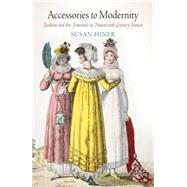Accessories to Modernity
, by Hiner, Susan- ISBN: 9780812242591 | 0812242599
- Cover: Hardcover
- Copyright: 6/10/2010
Accessories to Modernityexplores the ways in which feminine fashion accessories, such as cashmere shawls, parasols, fans, and handbags, became essential instruments in the bourgeois idealization of womanhood in nineteenth-century France. Considering how these fashionable objects were portrayed in fashion journals and illustrations, as well as fiction, the book explores the histories and cultural weight of the objects themselves and offers fresh readings of works by Balzac, Flaubert, and Zola, some of the most widely read novels of the period. As social boundaries were becoming more and more fluid in the nineteenth century, one effort to impose order over the looming confusion came, in the case of women, through fashion, and the fashion accessory thus became an ever more crucial tool through which social distinction could be created, projected, and maintained. Looking through the lens of fashion, Susan Hiner explores the interplay of imperialist expansion and domestic rituals, the assertion of privilege in the face of increasing social mobility, gendering practices and their relation to social hierarchies, and the rise of commodity culture and woman's paradoxical status as both consumer and object within it. Through her close focus on these luxury objects, Hiner reframes the feminine fashion accessory as a key symbol of modernity that bridges the erotic and proper, the domestic and exotic, and mass production and the work of art while making a larger claim about the "accessory" status-in terms of both complicity and subordination-of bourgeois women in nineteenth-century France. Women were not simply passive bystanders but rather were themselves accessories to the work of modernity from which they were ostensibly excluded.







